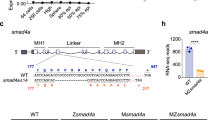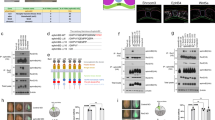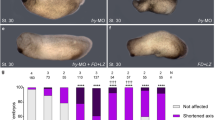Abstract
The mitogen-activated protein kinase/extracellular signal-regulated kinase (MAPK/ERK) and phosphatidylinositol-3-OH kinase (PI(3)K)/Akt pathways are involved in the regulatory mechanisms of several cellular processes including proliferation, differentiation and apoptosis. Here we show that during chick, mouse and zebrafish limb/fin development, a known MAPK/ERK regulator, Mkp3, is induced in the mesenchyme by fibroblast growth factor 8 (FGF8) signalling, through the PI(3)K/Akt pathway. This correlates with a high level of phosphorylated ERK in the apical ectodermal ridge (AER), where Mkp3 expression is excluded. Conversely, phosphorylated Akt is detected only in the mesenchyme. Constitutively active Mek1, as well as the downregulation of Mkp3 by small interfering RNA (siRNA), induced apoptosis in the mesenchyme. This suggests that MKP3 has a key role in mediating the proliferative, anti-apoptotic signalling of AER-derived FGF8.
This is a preview of subscription content, access via your institution
Access options
Subscribe to this journal
Receive 12 print issues and online access
$209.00 per year
only $17.42 per issue
Buy this article
- Purchase on Springer Link
- Instant access to full article PDF
Prices may be subject to local taxes which are calculated during checkout




Similar content being viewed by others
References
Goldfarb, M. Functions of fibroblast growth factors in vertebrate development. Cytokine Growth Factor Rev. 7, 311–325 (1996).
Ng, J.K., Tamura, K., Buscher, D. & Izpisua-Belmonte, J.C. Molecular and cellular basis of pattern formation during vertebrate limb development. Curr. Top. Dev. Biol. 41, 37–66 (1999).
Capdevila, J. & Izpisua Belmonte, J.C. Patterning mechanisms controlling vertebrate limb development. Annu. Rev. Cell Dev. Biol. 17, 87–132 (2001).
Niswander, L. Pattern formation: old models out on a limb. Nature Rev. Genet. 4, 133–143 (2003).
Martin, G.R. The roles of FGFs in the early development of vertebrate limbs. Genes Dev. 12, 1571–1586 (1998).
Javerzat, S., Auguste, P. & Bikfalvi, A. The role of fibroblast growth factors in vascular development. Trends Mol. Med. 8, 483–489 (2002).
Muda, M. et al. MKP-3, a novel cytosolic protein-tyrosine phosphatase that exemplifies a new class of mitogen-activated protein kinase phosphatase. J. Biol. Chem. 271, 4319–4326 (1996).
Groom, L.A., Sneddon, A.A., Alessi, D.R., Dowd, S. & Keyse, S.M. Differential regulation of the MAP, SAP and RK/p38 kinases by Pyst1, a novel cytosolic dual-specificity phosphatase. EMBO J. 15, 3621–3632 (1996).
Mourey, R.J. et al. A novel cytoplasmic dual specificity protein tyrosine phosphatase implicated in muscle and neuronal differentiation. J. Biol. Chem. 271, 3795–3802 (1996).
Smith, A. et al. Chromosomal localization of three human dual specificity phosphatase genes (DUSP4, DUSP6, and DUSP7). Genomics 42, 524–527 (1997).
Niehrs, C. & Pollet, N. Synexpression groups in eukaryotes. Nature 402, 483–487 (1999).
Powers, C.J., McLeskey, S.W. & Wellstein, A. Fibroblast growth factors, their receptors and signaling. Endocr. Relat. Cancer 7, 165–197 (2000).
Xu, X. et al. Fibroblast growth factor receptor 2 (FGFR2)-mediated reciprocal regulation loop between FGF8 and FGF10 is essential for limb induction. Development 125, 753–765 (1998).
Muda, M. et al. The dual specificity phosphatases M3/6 and MKP-3 are highly selective for inactivation of distinct mitogen-activated protein kinases. J. Biol. Chem. 271, 27205–27208 (1996).
Tsang, M., Friesel, R., Kudoh, T. & Dawid, I.B. Identification of Sef, a novel modulator of FGF signalling. Nature Cell Biol. 4, 165–169 (2002).
Furthauer, M., Lin, W., Ang, S.L., Thisse, B. & Thisse, C. Sef is a feedback-induced antagonist of Ras/MAPK-mediated FGF signalling. Nature Cell Biol. 4, 170–174 (2002).
Yordy, J.S. & Muise-Helmericks, R.C. Signal transduction and the Ets family of transcription factors. Oncogene 19, 6503–6513 (2000).
Fernandez-Teran, M., Piedra, M.E., Simandl, B.K., Fallon, J.F. & Ros, M.A. Limb initiation and development is normal in the absence of the mesonephros. Dev. Biol. 189, 246–255 (1997).
Stephens, T.D. et al. Axial and paraxial influences on the origin of the chick embryo limb. Prog. Clin. Biol. Res. 383A, 317–326 (1993).
Dickinson, R.J., Eblaghie, M.C., Keyse, S.M. & Morriss-Kay, G.M. Expression of the ERK-specific MAP kinase phosphatase PYST1/MKP3 in mouse embryos during morphogenesis and early organogenesis. Mech. Dev. 113, 193–196 (2002).
Klock, A. & Herrmann, B.G. Cloning and expression of the mouse dual-specificity mitogen-activated protein (MAP) kinase phosphatase Mkp3 during mouse embryogenesis. Mech. Dev. 116, 243–247 (2002).
Vogel, A., Rodriguez, C. & Izpisua-Belmonte, J.C. Involvement of FGF-8 in initiation, outgrowth and patterning of the vertebrate limb. Development 122, 1737–1750 (1996).
Ohuchi, H. & Noji, S. Fibroblast-growth-factor-induced additional limbs in the study of initiation of limb formation, limb identity, myogenesis, and innervation. Cell Tissue Res. 296, 45–56 (1999).
Isaac, A. et al. FGF and genes encoding transcription factors in early limb specification. Mech. Dev. 93, 41–48 (2000).
Grieshammer, U., Minowada, G., Pisenti, J.M., Abbott, U.K. & Martin, G.R. The chick limbless mutation causes abnormalities in limb bud dorsal–ventral patterning: implications for the mechanism of apical ridge formation. Development 122, 3851–3861 (1996).
Ros, M.A. et al. The limb field mesoderm determines initial limb bud anteroposterior asymmetry and budding independent of sonic hedgehog or apical ectodermal gene expressions. Development 122, 2319–2330 (1996).
Grandel, H., Draper, B.W. & Schulte-Merker, S. dackel acts in the ectoderm of the zebrafish pectoral fin bud to maintain AER signaling. Development 127, 4169–4178 (2000).
Sun, X., Mariani, F.V. & Martin, G.R. Functions of FGF signalling from the apical ectodermal ridge in limb development. Nature 418, 501–508 (2002).
Ong, S.H. et al. Stimulation of phosphatidylinositol 3-kinase by fibroblast growth factor receptors is mediated by coordinated recruitment of multiple docking proteins. Proc. Natl Acad. Sci. USA 98, 6074–6079 (2001).
Aoki, M., Batista, O., Bellacosa, A., Tsichlis, P. & Vogt, P.K. The akt kinase: molecular determinants of oncogenicity. Proc. Natl Acad. Sci. USA 95, 14950–14955 (1998).
Scheid, M.P. & Woodgett, J.R. PKB/AKT: functional insights from genetic models. Nature Rev. Mol. Cell Biol. 2, 760–768 (2001).
Brunet, A. et al. Nuclear translocation of p42/p44 mitogen-activated protein kinase is required for growth factor-induced gene expression and cell cycle entry. EMBO J. 18, 664–674 (1999).
Dudley, A.T., Ros, M.A. & Tabin, C.J. A re-examination of proximodistal patterning during vertebrate limb development. Nature 418, 539–544 (2002).
Wang, X., Martindale, J.L. & Holbrook, N.J. Requirement for ERK activation in cisplatin-induced apoptosis. J. Biol. Chem. 275, 39435–39443 (2000).
Stefanelli, C. et al. Caspase activation in etoposide-treated fibroblasts is correlated to ERK phosphorylation and both events are blocked by polyamine depletion. FEBS Lett. 527, 223–228 (2002).
Stanciu, M. & DeFranco, D.B. Prolonged nuclear retention of activated extracellular signal-regulated protein kinase promotes cell death generated by oxidative toxicity or proteasome inhibition in a neuronal cell line. J. Biol. Chem. 277, 4010–4017 (2002).
Wilkinson, D.G. in In Situ Hybridization (ed. Wilkinson, D. G.) 75–83 (Oxford Univ. Press, Oxford, 1992).
Hamburger, V. & Hamilton, H.L. A series of normal stages in the development of the chick embryo. J. Morph. 88, 49–92 (1951).
Harada, T., Morooka, T., Ogawa, S. & Nishida, E. ERK induces p35, a neuron-specific activator of Cdk5, through induction of Egr1. Nature Cell Biol. 3, 453–459 (2001).
Barton, G.M. & Medzhitov, R. Retroviral delivery of small interfering RNA into primary cells. Proc. Natl Acad. Sci. USA 99, 14943–14945 (2002).
McManus, M.T. & Sharp, P.A. Gene silencing in mammals by small interfering RNAs. Nature Rev. Genet. 3, 737–747 (2002).
Kanzler, B., Foreman, R.K., Labosky, P.A. & Mallo, M. BMP signaling is essential for development of skeletogenic and neurogenic cranial neural crest. Development 127, 1095–1104 (2000).
Acknowledgements
We thank G. Martin for providing limb-specific Fgf4;Fgf8 double-knockout mouse embryos, C. Nuesslein Volhard for the mutant zebrafish dackel, M. Aoki and P. Vogt for the constitutively active Akt construct, T. Jessell for the chick Pea3 and Er81 clones, E. Nishida for the constitutively active Mek1 clone, I. Dubova for his expertise and help with zebrafish, G. Sternik for his assistance with the microscopic analyses, and M. Tsuda for assistance with experiments. J.R.L. is supported by a fellowship from the Fundação Calouste Gulbenkian. T.I. is supported by a JSPS Postdoctoral Fellowship for Research Abroad, Japan. C.M.K. is partly supported by a postdoctoral fellowship from the Canadian Institutes of Health Research, J.K.N. is supported by an NIH training grant, and A.R. is partly supported by a postdoctoral fellowship from the Ministerio de Educación, Cultura y Deporte, Spain. H.A. is supported by the Arthritis Foundation and the Japan Science and Technology Cooperation. This work was supported by grants from BioCell, Fundacao Calouste Gulbenkian e Fundacao para Ciencia e Technologia, the Arthritis Foundation, the G. Harold and Leila Y. Mathers Charitable Foundation, the National Science Foundation, and the National Institutes of Health.
Author information
Authors and Affiliations
Corresponding author
Ethics declarations
Competing interests
The authors declare no competing financial interests.
Rights and permissions
About this article
Cite this article
Kawakami, Y., Rodríguez-León, J., Koth, C. et al. MKP3 mediates the cellular response to FGF8 signalling in the vertebrate limb. Nat Cell Biol 5, 513–519 (2003). https://doi.org/10.1038/ncb989
Received:
Accepted:
Published:
Issue Date:
DOI: https://doi.org/10.1038/ncb989
This article is cited by
-
Dusp6 deficiency attenuates neutrophil-mediated cardiac damage in the acute inflammatory phase of myocardial infarction
Nature Communications (2022)
-
Hoxd13/Bmp2-mediated mechanism involved in zebrafish finfold design
Scientific Reports (2021)
-
FGF signaling controls Shh-dependent oligodendroglial fate specification in the ventral spinal cord
Neural Development (2018)
-
Atrial ERK1/2 activation in the embryo leads to incomplete Septal closure: a novel mouse model of atrial Septal defect
Journal of Biomedical Science (2017)
-
Regulation of Sema3c and the Interaction between Cardiac Neural Crest and Second Heart Field during Outflow Tract Development
Scientific Reports (2017)



